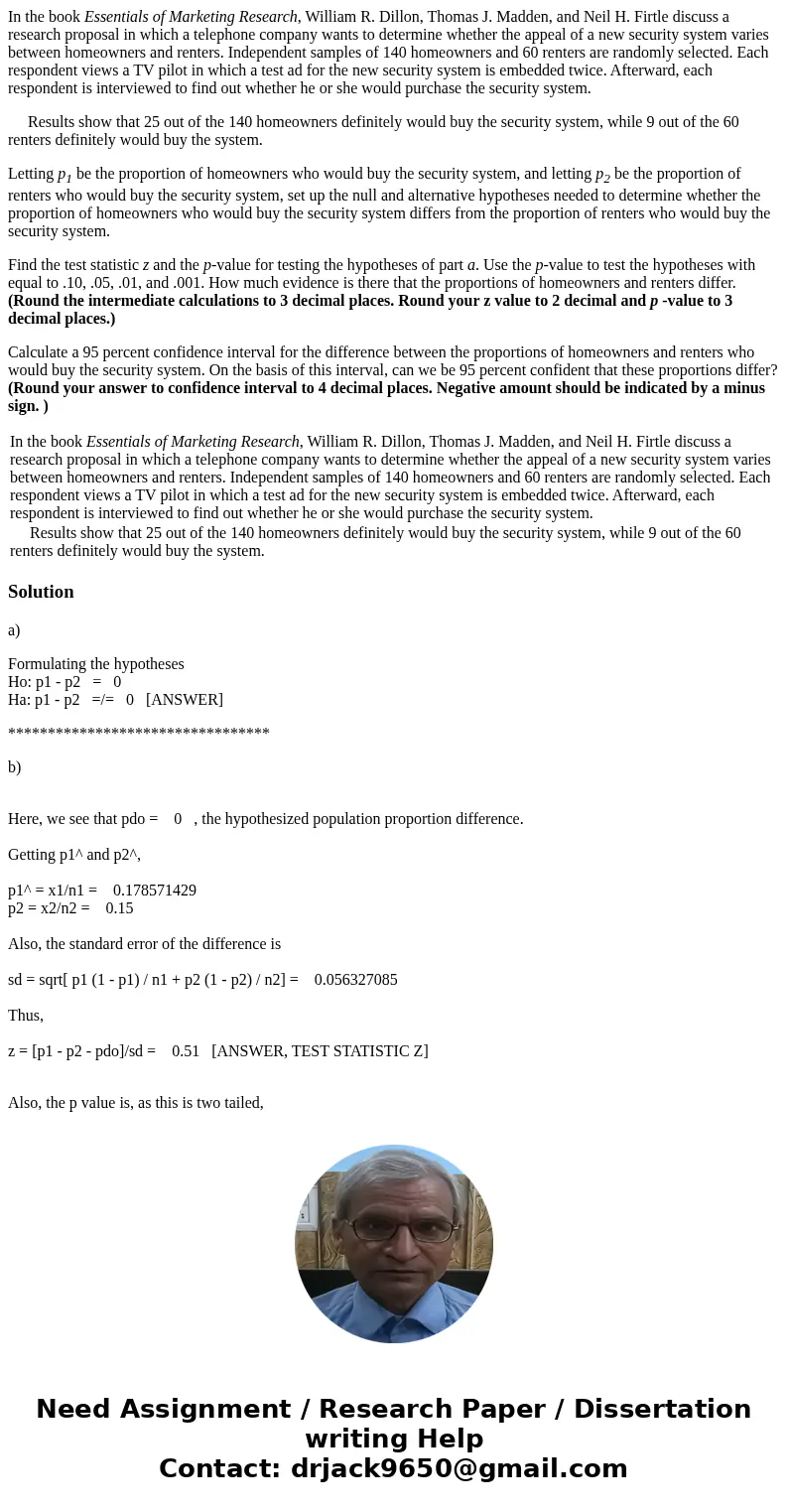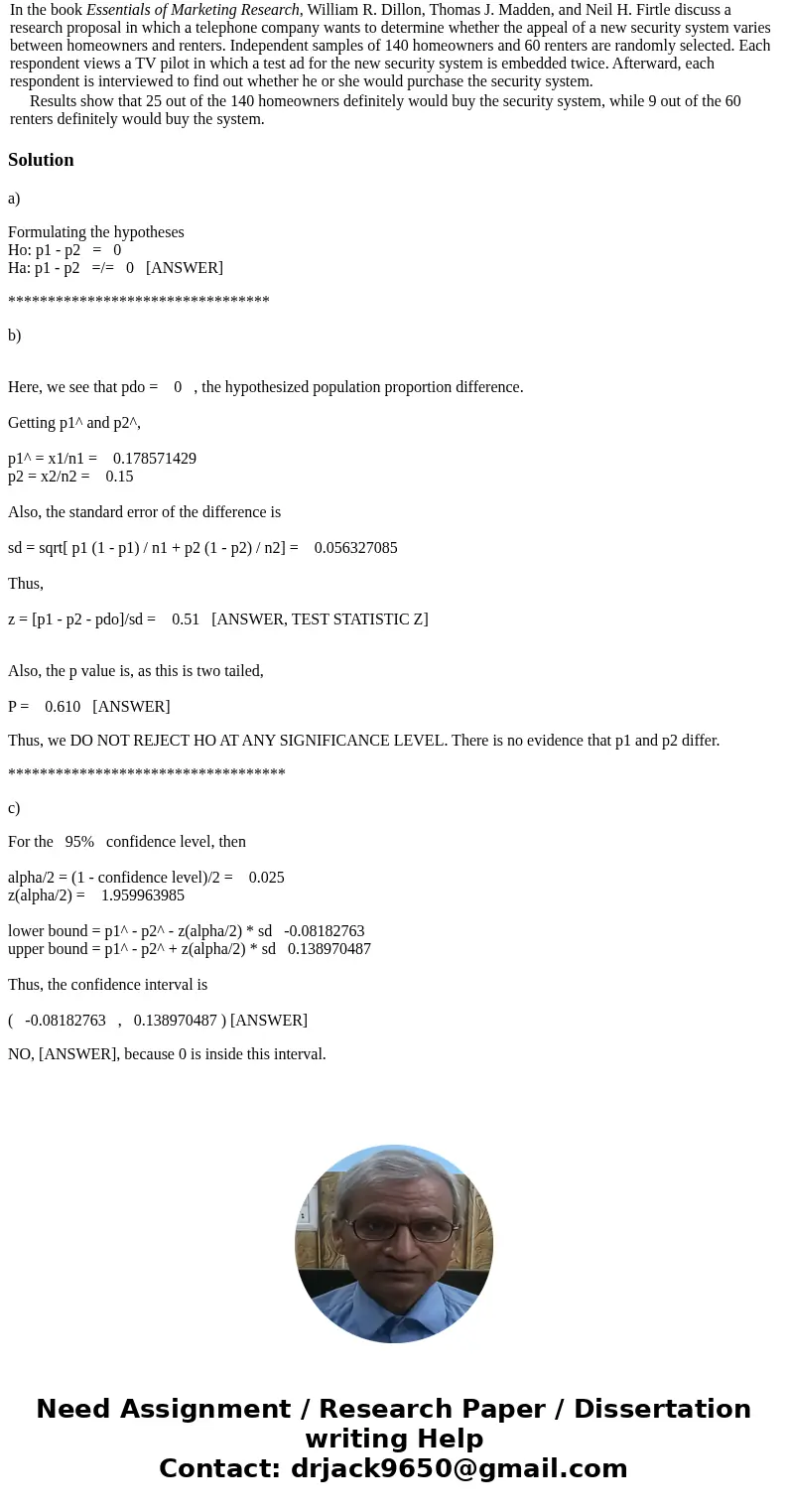In the book Essentials of Marketing Research William R Dillo
In the book Essentials of Marketing Research, William R. Dillon, Thomas J. Madden, and Neil H. Firtle discuss a research proposal in which a telephone company wants to determine whether the appeal of a new security system varies between homeowners and renters. Independent samples of 140 homeowners and 60 renters are randomly selected. Each respondent views a TV pilot in which a test ad for the new security system is embedded twice. Afterward, each respondent is interviewed to find out whether he or she would purchase the security system.
Results show that 25 out of the 140 homeowners definitely would buy the security system, while 9 out of the 60 renters definitely would buy the system.
Letting p1 be the proportion of homeowners who would buy the security system, and letting p2 be the proportion of renters who would buy the security system, set up the null and alternative hypotheses needed to determine whether the proportion of homeowners who would buy the security system differs from the proportion of renters who would buy the security system.
Find the test statistic z and the p-value for testing the hypotheses of part a. Use the p-value to test the hypotheses with equal to .10, .05, .01, and .001. How much evidence is there that the proportions of homeowners and renters differ.(Round the intermediate calculations to 3 decimal places. Round your z value to 2 decimal and p -value to 3 decimal places.)
Calculate a 95 percent confidence interval for the difference between the proportions of homeowners and renters who would buy the security system. On the basis of this interval, can we be 95 percent confident that these proportions differ? (Round your answer to confidence interval to 4 decimal places. Negative amount should be indicated by a minus sign. )
| In the book Essentials of Marketing Research, William R. Dillon, Thomas J. Madden, and Neil H. Firtle discuss a research proposal in which a telephone company wants to determine whether the appeal of a new security system varies between homeowners and renters. Independent samples of 140 homeowners and 60 renters are randomly selected. Each respondent views a TV pilot in which a test ad for the new security system is embedded twice. Afterward, each respondent is interviewed to find out whether he or she would purchase the security system. |
| Results show that 25 out of the 140 homeowners definitely would buy the security system, while 9 out of the 60 renters definitely would buy the system. |
Solution
a)
Formulating the hypotheses
Ho: p1 - p2 = 0
Ha: p1 - p2 =/= 0 [ANSWER]
*********************************
b)
Here, we see that pdo = 0 , the hypothesized population proportion difference.
Getting p1^ and p2^,
p1^ = x1/n1 = 0.178571429
p2 = x2/n2 = 0.15
Also, the standard error of the difference is
sd = sqrt[ p1 (1 - p1) / n1 + p2 (1 - p2) / n2] = 0.056327085
Thus,
z = [p1 - p2 - pdo]/sd = 0.51 [ANSWER, TEST STATISTIC Z]
Also, the p value is, as this is two tailed,
P = 0.610 [ANSWER]
Thus, we DO NOT REJECT HO AT ANY SIGNIFICANCE LEVEL. There is no evidence that p1 and p2 differ.
***********************************
c)
For the 95% confidence level, then
alpha/2 = (1 - confidence level)/2 = 0.025
z(alpha/2) = 1.959963985
lower bound = p1^ - p2^ - z(alpha/2) * sd -0.08182763
upper bound = p1^ - p2^ + z(alpha/2) * sd 0.138970487
Thus, the confidence interval is
( -0.08182763 , 0.138970487 ) [ANSWER]
NO, [ANSWER], because 0 is inside this interval.


 Homework Sourse
Homework Sourse